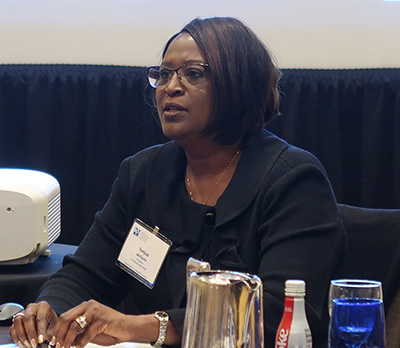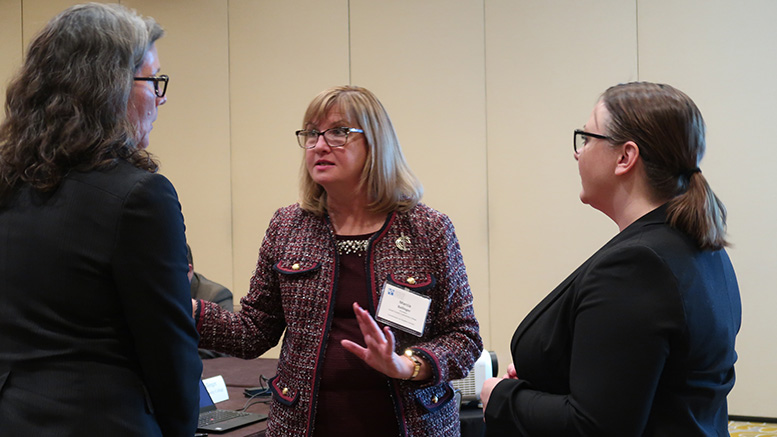Faculty must play a key role in keeping students on a pathway to college completion, according to findings from a student engagement survey conducted at St. Petersburg College (SPC) in Florida.
One of the findings from the survey is that when students are struggling academically, they want to talk to faculty, not an advisor or administrator, said SPC President Tonjua Williams, who shared some of the survey results and subsequent actions during this week’s Fall Meeting of the American Association of Community Colleges held in Arlington, Virginia.
“The faculty is the most important, pivotal group on campus to get students to come back semester after semester,” Williams told members of AACC’s Commission on Student Success.
Access to data
As a result of the findings, SPC switched responsibility for its early alert system from student services to faculty, who now use the Desire2Learn system to provide information directly to students, including grades and attendance reports. Advisors can access the system, too, and can add notes about what they’re doing to support the student.
Letting students know their grades in a timely manner can have a big impact on retention, Williams said. In the past, some students would drop out of a class because they erroneously thought they were failing. In other instances, students didn’t get a course syllabus until the second week of classes. Now, faculty are required to post a syllabus online before the course starts.
When Williams talked about these issues with faculty, she found they thought they had better communications with students than they actually did.
“Giving faculty access to data empowers them,” Williams said. “Let faculty take the lead on coming up with solutions.”
Smoother onboarding
When a consultant told Williams 10 years ago that the college’s onboarding process was “horrible,” she didn’t believe it. But when she tried to apply to SPC herself, “It took me two days to get through the process, and I never heard whether I got in or not,” she said.
That exercise, repeated by other college administrators, led to a streamlined application process that now takes just 10 minutes.
Surveys of students also found that most of them didn’t know what they wanted to study in college, Williams said, and when students don’t see a clear path ahead, they’re less likely to complete.

Tonjua Williams, president of St. Petersburg College.
To address that issue, SPC added case managers and required them to receive training as professional career service advisors. Also, newly enrolled students had to complete a self-assessment that steers them toward a pathway that best suits them.
Now when students are accepted into the college, they get a congratulatory letter and a link to the self-assessment. And when they see their advisor for the first time, the advisor already knows what they are interested in and helps them get onto a pathway.
“We have to realize there is nothing wrong with our students,” Williams said. “It is us. We have to do something different. We need to change our behavior.”
Faculty are hired to teach, but colleges need to make sure they are responsible for student learning.
“We have to practice courage over comfort,” Williams added.
Reducing equity gaps
Community colleges can’t raise completion rates or reduce equity gaps unless they can measure where they are and set goals for improvement, Marcia Ballinger, president of Lorain County Community College (LCCC) in Ohio, told the commission.
After discovering that her college had huge gaps in achievement among various demographic groups, LCCC began an initiative in 2011 to create a vision focused on “equity of opportunity,” Ballinger said.
“When we began this journey and started digging into the data, we had a rude awakening when we realized that only 8 percent of full-time students graduate within three years,” she said. For African-American students, it was zero.
A series of initiatives, policy changes and improved data analyses since then has led to solid results: As of 2011, the number of degrees and certificates conferred has increased by 79 percent overall, 149 percent for Hispanic students and 128 percent for African-American students.
A bold vision
The effort to change the culture started with creating a “vision network” with stakeholders from the college and the community. The vision focused on five areas: the student (expand participation), success (increase completion and academic success), future (foster future success), work (improve economic competitiveness) and community (enhance quality of life).
From that framework, LCCC drafted a series of success indicators grouped into four categories: connection, entry, progress and completion, with the data disaggregated by race/ethnicity and whether students are first-generation college students or eligible for Pell grants.
One result of that process was a goal, “10,000 degrees of impact by 2025,” approved by the LCCC board earlier this year. That calls for the college to graduate 10,000 more people aligned with high-demand skills in the community over the next six years.
That goal is bold, Ballinger acknowledged, but “if you don’t measure something, it doesn’t get done.”
Data is critical because having a policy doesn’t mean it’s going to be implemented, she noted. For example, college policy required all students to have an advisor, but an examination of the data found the actual number was only 30 percent.
With assistance from the Gates Foundation and consultant Byron McClenney, the college developed a set of key indicators that could move the needle in improving student success, and it took steps aimed at getting results. One key change was eliminating the college’s eight levels of 16-week developmental math courses, which was a major barrier to college completion. Instead, it adopted an accelerated co-requisite model for developmental education.
As a result, the number of students who completed college-level English their first year increased 18 percentage points over eight years, Ballinger said. The gains were 33 percentage points for African-Americans and 24 points for Hispanics.
The college also stopped requiring algebra for everyone and added two other math pathways – statistics and quantitative reasoning – which also contributed to the number of students completing college-level math.
A big improvement
Among other improvements over the past eight years, the number of students who earned no credits during the first term dropped from 25 percent to 17 percent. Another key change that led to a big increase in completion rates was encouraging students to complete 15 credit hours their first year.
LCCC also made it mandatory to give students a midterm grade and required students to meet with their instructor before they can withdraw from a course.
The number of students who completed three key performance indicators in their first year – completed college-level English and college-level math and earned 15 or more credits – increased from 12 percent in 2011, to 29 percent in 2019.
LCCC made its data findings available to everyone on campus, allowing them to look at trends and aggregate the data in a variety of ways. Faculty can see completion rates for their courses and compare them to that of other instructors’ courses, for example.
“When you put this information out in a way that’s easy to use, that is truly powerful,” Ballinger said.
The college’s efforts to improve student success is based on “a culture of caring,” she said. “It’s our culture that undergirds our success. It’s the actions taken everyday to invest in the success of every student.”
As a result of the improved completion rates, LCCC now has overflow seating at graduation ceremonies, had to require tickets for graduates’ guests and is looking for a larger venue.
“That’s a good problem to have,” Ballinger said.

